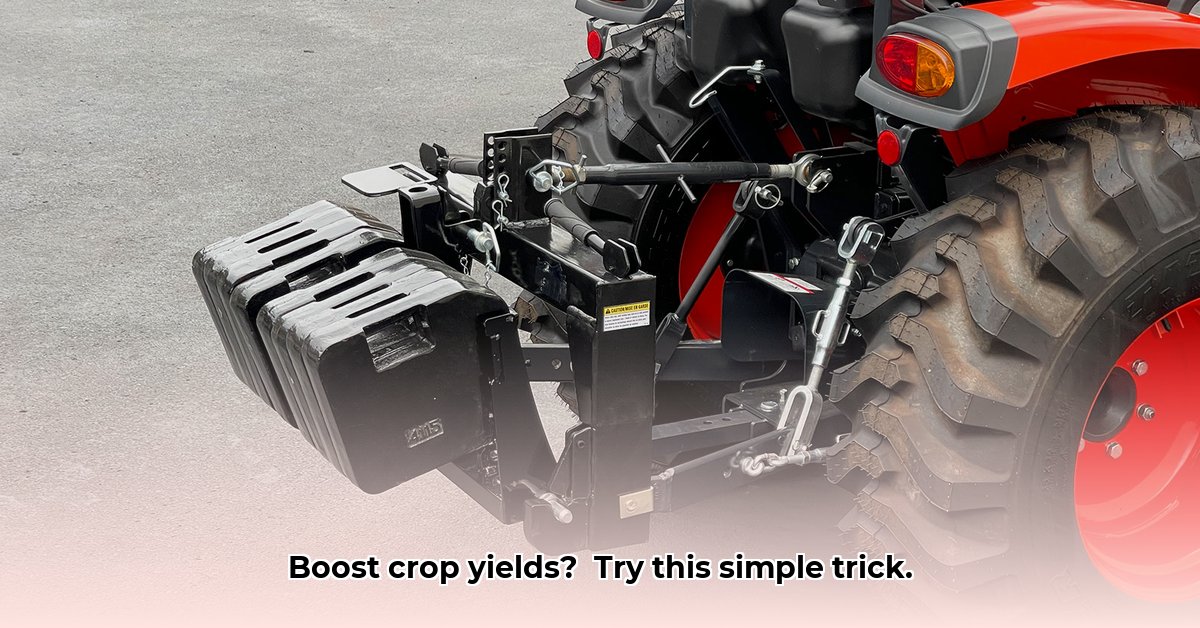
Rear Tractor Weights: Optimizing Efficiency and Protecting Soil Health
Choosing the right rear tractor weights is crucial for maximizing yields while minimizing environmental impact. Selecting appropriate weights isn't simply about adding heft; it's a strategic decision impacting soil health, fuel efficiency, and overall farm sustainability. This guide will help farmers and dealers understand the factors influencing weight selection and make informed choices aligned with sustainable agricultural practices. For more information on tractor weights, see this helpful guide: Tractor Ballast Weights.
Understanding Your Tractor's Weight Needs: A Comprehensive Assessment
Determining the optimal weight for your tractor requires a nuanced understanding of several interconnected factors. These factors will influence your traction, soil compaction, and overall operational efficiency.
Soil Type and Conditions: Adapting to Varied Terrains
Soil type significantly affects weight requirements. Heavy clay soils generally offer more traction than lighter sandy soils, thus potentially requiring less added weight. Sandy soils, prone to slippage, necessitate heavier weights to maintain stability and prevent wheel spin. Soil moisture content also plays a crucial role; wet conditions drastically reduce traction, increasing the need for additional weight.
Tractor Size and Power: Balancing Strength and Stability
Larger, more powerful tractors often require more weight to fully utilize their capabilities and prevent wheel slippage. Finding the right balance between tractor power and counterweight is crucial for optimal performance. Under-weighting a powerful tractor can lead to reduced traction and increased fuel consumption, while over-weighting may cause excessive soil compaction.
Farming Practices: Impact on Soil and Weight Selection
Farming practices heavily influence weight requirements. Intensive tillage operations demand more weight than no-till methods. No-till farming reduces soil disturbance and compaction, potentially lessening the need for significant rear weights. Therefore, a farmer using a no-till approach might require less weight than one engaged in conventional tillage.
Implement Type and Size: Matching Load Capacity
The size and weight of implements attached to the tractor directly affect the required counterweight. Heavier implements, such as large planters or cultivators, necessitate more weight to maintain stability and prevent the tractor from tipping or losing traction. Always consult your tractor's manual for weight recommendations based on the implemented used.
Terrain and Slope: Navigating Challenging Conditions
Steep slopes and uneven terrains impose higher stability and traction demands. Increased weight is often required to maintain control and prevent accidents in these challenging conditions. This is particularly true for hilly regions or fields with uneven surfaces.
The Supplier Landscape: An Overview of Key Players
Two major suppliers of rear tractor weights are Lonestar Weights and Taylor Foundry. Both offer a range of weight options compatible with various tractor makes and models. Lonestar Weights is known for its customizable options, catering to specific needs, while Taylor Foundry prioritizes durability and longevity in its products. Both companies typically boast extensive distribution networks, ensuring geographically widespread availability. Farmers should compare offerings, pricing, lead times, warranties, and customer support to make informed decisions.
Sustainability in Weight Selection: Environmental Considerations
Sustainable farming necessitates responsible choices at every stage of the process. Considering the environmental impact of rear tractor weights is paramount.
Material Sourcing and Manufacturing: Minimizing the Footprint
The choice of materials influences the environmental footprint. Weights made from recycled steel significantly reduce the demand for virgin materials and associated energy consumption. Suppliers committed to sustainable manufacturing processes further minimize their environmental impact. Seek out suppliers that emphasize recycling and responsible sourcing practices.
Transportation and Logistics: Reducing Emissions
Transportation distances impact the carbon footprint. Prioritizing local suppliers minimizes the environmental impact of transportation. Furthermore, efficient logistics and bulk shipping options can contribute to substantial emissions reductions.
End-of-Life Management: Responsible Disposal
Planning for the end-of-life management of weights is critical. Weights made from recyclable materials should be recycled rather than discarded. Suppliers with end-of-life management programs demonstrate environmental leadership. Proper disposal methods should be considered to minimize environmental risks.
Actionable Steps for Farmers and Dealers: A Practical Guide
Choosing the right rear tractor weights is a process that requires careful planning and consideration. These steps offer a practical framework to ensure optimal results:
- Thorough Needs Assessment: Conduct a comprehensive assessment considering soil types, tractor specifications, farming practices, typical implements, and terrain conditions.
- Supplier Research: Investigate multiple reputable suppliers, comparing their product offerings, pricing, shipping costs, sustainability initiatives, and customer support.
- Prioritize Sustainability: Inquire about materials used, manufacturing processes, and commitment to environmental responsibility. Prioritize weights made from recycled materials whenever possible.
- Best Practices Implementation: Follow recommended weight placement and maintenance guidelines to ensure optimal performance and minimize soil compaction. Avoid over-weighting and distribute weights evenly.
- Monitoring and Adjustment: Regularly evaluate the effectiveness of chosen weights, making adjustments as needed to maintain optimal traction without compromising soil health.
Conclusion: Sustainable Practices for Long-Term Success
Sustainable farming hinges on a holistic approach, prioritizing both yield enhancement and environmental stewardship. Choosing the right rear tractor weights is a key aspect of this approach. By carefully weighing the relevant factors, farmers and dealers can make informed decisions that maximize efficiency while minimizing environmental impacts. This strategic approach ensures sustainable and profitable farming practices for years to come.